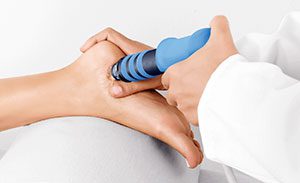All about Shockwave Therapy or ESWT (Extracorporeal Shock Wave Therapy) at NYC Podiatry center:
What is Shockwave Therapy?
 Shockwave therapy, also known as Extracorporeal Shock Wave Therapy (ESWT) is a noninvasive surgical procedure. It uses sound waves to stimulate healing in some physical disorders, including plantar fasciitis. “Extracorporeal” stands for “outside of the body” and refers to the way the therapy is applied. Because there is no incision, shockwave therapy (ESWT) offers two main advantages over traditional surgical methods: fewer complications and a faster return to normal activity. NYC Podiatry Center of Excellence is one of the few premier centers in NYC offering this latest technology to treat chronic foot pain / plantar fasciitis and other foot disorders. In addition, our doctor is board certified and specifically trained to do this treatment.
Shockwave therapy, also known as Extracorporeal Shock Wave Therapy (ESWT) is a noninvasive surgical procedure. It uses sound waves to stimulate healing in some physical disorders, including plantar fasciitis. “Extracorporeal” stands for “outside of the body” and refers to the way the therapy is applied. Because there is no incision, shockwave therapy (ESWT) offers two main advantages over traditional surgical methods: fewer complications and a faster return to normal activity. NYC Podiatry Center of Excellence is one of the few premier centers in NYC offering this latest technology to treat chronic foot pain / plantar fasciitis and other foot disorders. In addition, our doctor is board certified and specifically trained to do this treatment.
What is Plantar Fasciitis?
Plantar fasciitis is the most common form of heel pain. This painful condition results from inflammation of the plantar fascia – the connective tissue that stretches from the heel bone, across the arch, and to the base of the toes. Plantar fasciitis is sometimes also called heel spur syndrome when a spur (bony protrusion) is present.
Who is a Candidate for ESWT?
ESWT may be considered as a therapeutic option for the patient whose heel pain has not resolved with conservative treatment. Conservative measures include the use of anti-inflammatory medications, steroid injections, ice packs, stretching exercises, orthotic devices (shoe inserts), and physical therapy.
What to Expect With ESWT?
In preparation for ESWT, the foot and ankle surgeon will instruct the patient to stop taking any anti-inflammatory medications (for example, aspirin or ibuprofen) for about five days before the procedure. It is important to avoid these medications because they are known to prolong bleeding under the surface of the skin.
ESWT is performed on an outpatient basis, so it does not require an overnight stay in the hospital. Before the procedure begins, the patient is comfortably positioned and may receive local and/or sedation anesthesia. The treatment may take up to 30 minutes per foot. During the procedure, sound waves penetrate the heel area and stimulate the healing response. Sometimes more than one session is needed to adequately treat the inflammation and reduce the patient´s symptoms.
After the Procedure
The foot and ankle surgeon may advise you to have someone drive you home after the procedure. Other instructions may include:
- Rest and elevate the foot for the remainder of the day and night.
- Resume gentle stretching exercises the day following the procedure.
- Avoid taking any anti-inflammatory medication, such as ibuprofen or aspirin, for up to four weeks after ESWT.
- Avoid heavy lifting until the surgeon approves resuming this activity.
- You may walk on the foot.
- Avoid running or excessive activity.
- Avoid going barefoot during the healing process.
- Wear supportive shoes.
- In some instances, shoe insert(s) may be prescribed.
Although patients sometimes feel they can return to normal activities right away, the surgeon will determine when that is appropriate for your situation. It is important to use caution and follow the doctor’s instructions to avoid injuring the treated foot. Because ESWT temporarily reduces or eliminates the sensation of pain, patients sometimes become too active too soon.
ESWT is very safe and effective, but every surgical procedure carries the possibility of complications. In addition to mild pain and tingling or numbness, bruising and swelling sometimes develop after ESWT. There have also been reports of rupture of the plantar fascia and damage to the blood vessels or nerves.
Shockwave Therapy in the Future
Like many other innovative noninvasive therapies, Shockwave Therapy is an evolving technology. As more research on this technique continues to expand, the result will be additional uses for ESWT that will benefit more patients in the future.
Q. What are the success rates of the shockwave therapy for the treatment of plantar fasciitis? How many sessions does it usually take?
A: Shockwave therapy for plantar fasciitis usually takes 3-4 sessions and we see a 70% success rate. Our physicians can also discuss other options once they get a sense of your exact condition.
Please visit Shockwave Therapy Q&A for more questions and answers relating to shock wave treatment.
If you have plantar fasciitis and/or other foot disorders, Shockwave Therapy may be right for you. Please also visit the following link for more information about chronic heel pain, also known as Plantar Fasciitis.
Feel free to contact our office in Midtown East NYC for an appointment to discuss and/or receive shockwave therapy for chronic heel pain, or call us at Tel. (212) 288-3137.
- Podiatrist that does Telemedicine / Video Calls - March 28, 2020
- Podiatrists Accept EmblemHealth and GHI Insurance Plans - October 11, 2018
- NYC’s Celebrity Podiatrist for film, entertainment, athletic and modeling industries - September 20, 2018






